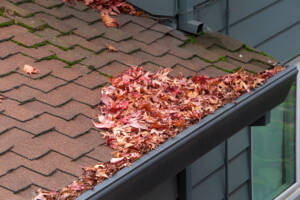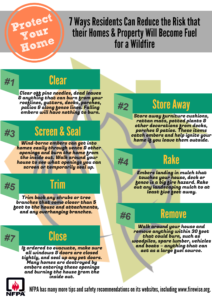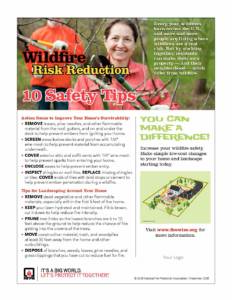Gutters
 Gutters play a role in providing a means of collecting and directing rainwater from the roof into downspouts, and then away from the house. This helps reduce the amount of water in the soil that can enter the crawlspace or basement and result in moisture-related performance problems such as those from mold and wood decay fungi.
Gutters play a role in providing a means of collecting and directing rainwater from the roof into downspouts, and then away from the house. This helps reduce the amount of water in the soil that can enter the crawlspace or basement and result in moisture-related performance problems such as those from mold and wood decay fungi.
Combustible debris such as leaves and pine needles can accumulate in gutters, especially from nearby or overhanging trees. Due to difficulty in accessing upper stories of a home, gutters two and three floors high are even more problematic, since they will be difficult to clean out on a regular basis. If ignited, combustible debris in the gutter will expose the edge of the roof covering, typically the fascia and or roof sheathing. Depending on the condition of the wood and presence (or absence) of metal flashing at the edge of the roof, debris in the gutter may make it easier for fire to enter the attic. Metal flashing at the roof edge will provide additional protection to the roof edge and therefore is a recommended detail.
Metal gutters have been recommended over plastic gutters in fire hazard areas. Embers will ignite accumulated debris in any gutter. Metal gutters will stay in place, and therefore the resulting fire will continue to burn at the roof edge. Vinyl (or plastic) gutters will quickly detach and fall to the ground. The debris and combustible gutter material will continue to burn, igniting any combustibles (mulch, vegetation, wood piles) and potentially any combustible siding. Flames can be high enough to impinge on windows. If you have vinyl gutters, a noncombustible (or low flammability) zone near the home is critical (e.g., use noncombustible rock mulch and carefully selected and maintained vegetation). If you have metal gutters, make sure the components at the roof edge are well maintained. Regardless of the gutter material, clean out debris in the gutter on a regular basis.
 Gutter guards or covers can be installed over or in your gutters. When properly installed (and maintained), these can reduce the amount of vegetation litter and debris that accumulate in your gutter and therefore reduce the need to clean it. Some products can become dislodged over time, and they will have to be reinstalled when this happens. Some products can result in the accumulation of debris on the roof, behind the gutter. There are a number of commercially available products specifically intended for this purpose – just type gutter guard in a web-browser search engine to get an idea of the available products. To date, there isn’t a standard procedure to evaluate the performance of these products.
Gutter guards or covers can be installed over or in your gutters. When properly installed (and maintained), these can reduce the amount of vegetation litter and debris that accumulate in your gutter and therefore reduce the need to clean it. Some products can become dislodged over time, and they will have to be reinstalled when this happens. Some products can result in the accumulation of debris on the roof, behind the gutter. There are a number of commercially available products specifically intended for this purpose – just type gutter guard in a web-browser search engine to get an idea of the available products. To date, there isn’t a standard procedure to evaluate the performance of these products.
ROOF AND GUTTER CLEANING TIPS
- Be safe!
- Hire a professional if you are unsure or lack the proper tools. Some roofing materials can be damaged if you walk on them, and every roof poses a fall hazard.
- Always use a sturdy, well-footed ladder to reach your roof and gutters.
- Don’t clean your roof alone. Be sure there is someone with you, on the ground, to help when needed.
- Check your roof. Is it well maintained? Is the roofing made from a fire resistant (Class “A”) material like tile, composite shingles, or tar and gravel? It can be difficult to tell whether you have a Class “A” fire-rated roof, unless it’s made of an obviously noncombustible material, such as tile. If you are not sure about your roof, schedule a professional roof inspection to find out.
- Always keep your roof clean of debris. Clean it as often as necessary during fire season. Remember: even a tiny handful of leaves is enough to burn your home!
- Check your gutters. Metal gutters are safest, and all gutters must be maintained completely free of leaves, needles, and vegetation during fire season (and the rainy season too, or course). Like the rest of your roof, you may need to clean them more often during the summer if you live in an area where leaves are likely to fall onto your roof.
Resource credit: FIRESafe MARIN
Resources
- Home Survival in Wildfire-Prone Areas: Building Materials and Design Considerations: ANR Publication 8393 6
- Home Landscaping for Fire. University of California Publication 8228. 2007. University of California, Davis.
- www.readyforwildfire.org. Wildfire is Coming: Are You Ready. CAL FIRE. 2012.
- Urban Forestry Associates. Ray Moritz, Urban Forester and Fire Ecologist.
- Protecting Your Home From Wildfire. 2017. Insurance Institute for Business & Home Safety
PREPAREDNESS MENU
Prepare your Home
RESOURCES
Seven ways residents can reduce wildfire risk infographic by NFPA
Download the free wildfire safety infographic with seven tips for residents to help protect their homes in an event of a wildfire.
Wildfire risk reduction safety tips by NFPA
By working together, residents can make their own property, and their neighborhood, much safer from wildfire.


